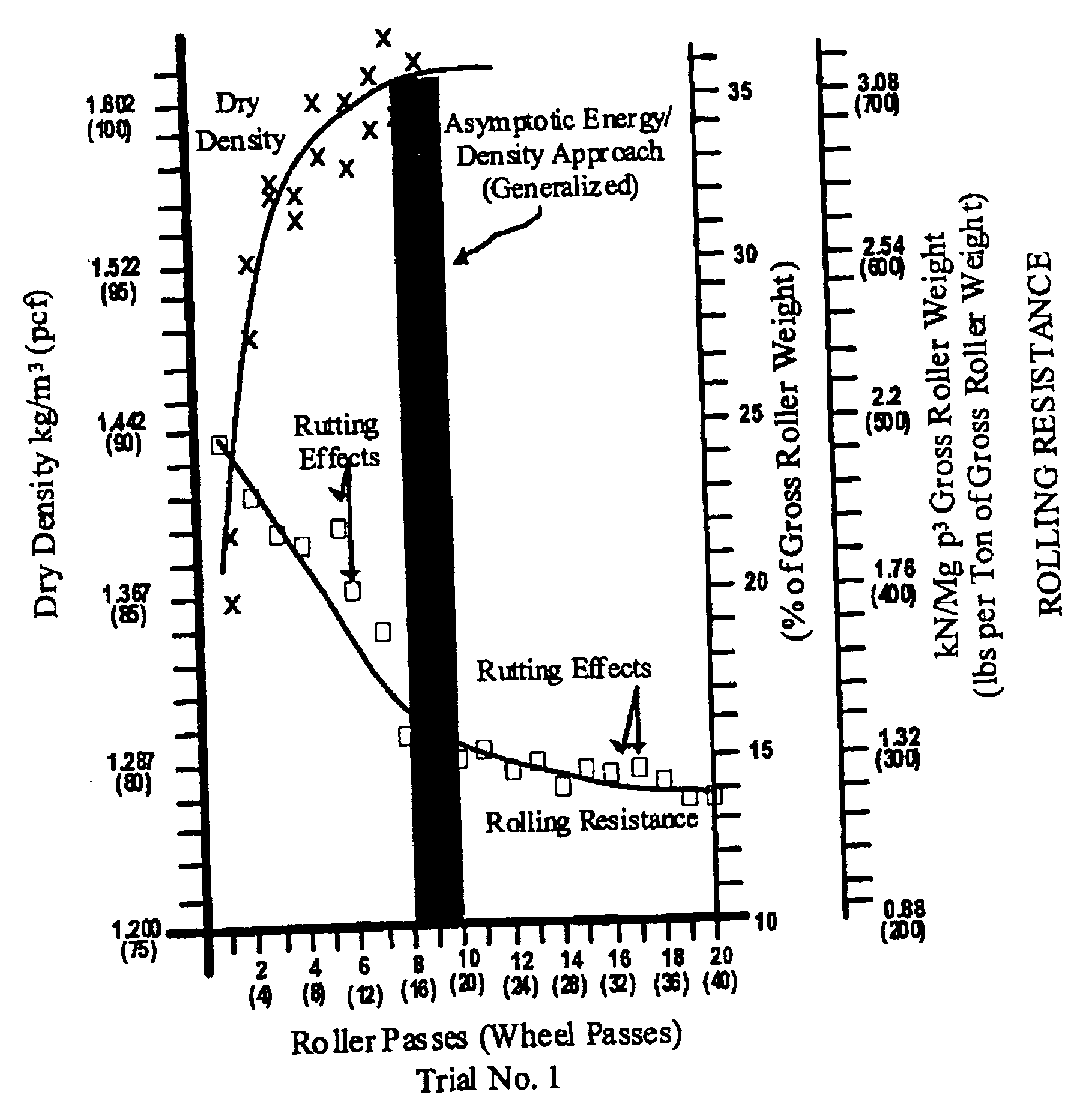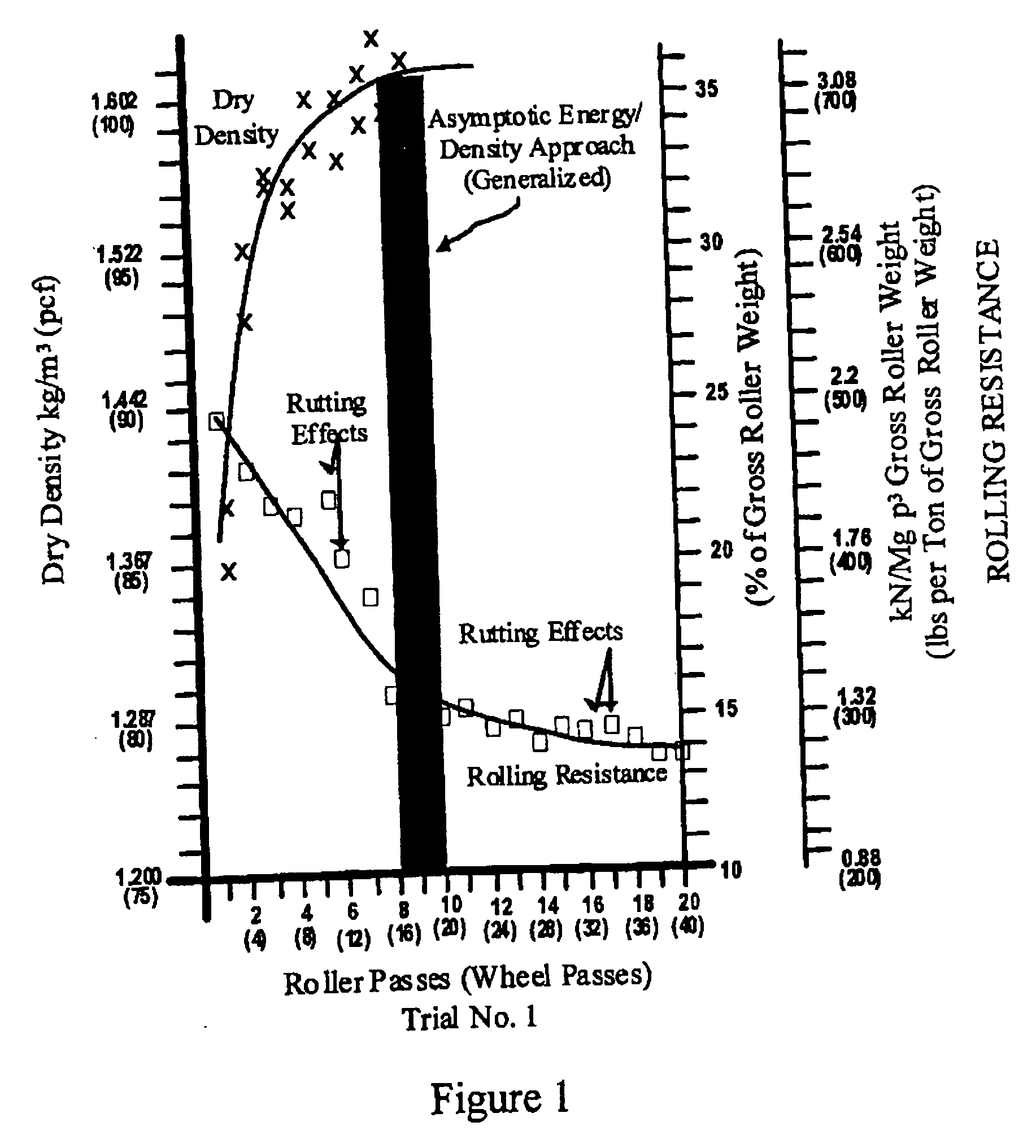Engineering design and construction of earthen fills
a technology of earthen filling and engineering design, applied in the field of new methods for and in earthen filling engineering and construction, can solve the problems of substantial compression of high filling constructed by using standard proctor energy, and achieve the effect of reducing the cost of construction and improving the quality of construction
- Summary
- Abstract
- Description
- Claims
- Application Information
AI Technical Summary
Benefits of technology
Problems solved by technology
Method used
Image
Examples
example 1
[0019] In a field test program the rolling resistance of a wheel / ground system suitable for earthen fill construction is measured relative to soil type, compactor type, soil lift thickness, moisture content, dry density, soil amendments, and roller passes. A specific test pad design is built with a certain soil type at different loose lift thickness', moisture contents, and soil amendments. Various earthwork compactors are used for the test and the compactor's performance parameters and specifications are recorded. The field test program consists of a series of at least three test trials. For each lift thickness, initial moisture content, soil type, soil amendment, and compactor type, each trial involves the determination of rolling resistance, soil dry density, and soil moisture content with each roller pass, and other engineering properties at and within the asymptotic energy-density approach range. Each trial is conducted with a different initial moisture content in order to test...
example 2
[0020] The invention includes a method for computation of cumulative average rolling resistance for each field trial from the best fit parabolic data curve formed by the trials. This is accomplished as follows:
[0021] For each rolling resistance vs. dry density curve produced by plotting the measured results for several data points in each pass of each field trial, new compaction data is drawn directly from the best fit, parabolic curve formed by plotting the rolling resistance variance with roller passes. Along the line of the curve, rolling resistance values for each wheel pass are drawn directly from the curve, for cumulative averaging. The cumulative averages are made with values taken from the first wheel pass up to the select pass at or within the novel asymptotic energy-density approach. The cumulative averages representing values at the novel asymptotic energy approach are then used for computing unit cumulative compaction energy per unit volume or for use in determining “de...
example 3
[0022] The invention includes a method to determine the novel “design energy level” based on selection of a specific percentage density sector of the derived moisture-density curves at or within the novel asymptotic energy-density approach, which is projected onto a corresponding moisture-compaction energy curve. This is accomplished as follows:
[0023] Using novel curves of compaction energy vs. moisture content, superimposed with corresponding dry density vs. moisture content curves, covering the novel asymptotic energy-density approach, a specific percentage density sector is selected or “notched” out of the select or corresponding density curve(s) in order to define a “design range” of moisture contents. The specific percentage value is selected within the range of 50 to 100% of the maximum density values on the derived moisture density curves, based on engineering needs with the new engineering methods. These needs include project-specific criticality and factor of safety intent...
PUM
 Login to View More
Login to View More Abstract
Description
Claims
Application Information
 Login to View More
Login to View More - R&D
- Intellectual Property
- Life Sciences
- Materials
- Tech Scout
- Unparalleled Data Quality
- Higher Quality Content
- 60% Fewer Hallucinations
Browse by: Latest US Patents, China's latest patents, Technical Efficacy Thesaurus, Application Domain, Technology Topic, Popular Technical Reports.
© 2025 PatSnap. All rights reserved.Legal|Privacy policy|Modern Slavery Act Transparency Statement|Sitemap|About US| Contact US: help@patsnap.com


